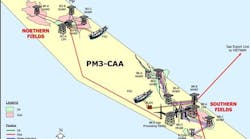The essential question at a Dec. 7 Center for Strategic and International Studies seminar was whether North America is on the verge of a tight oil boom in the next 10 years comparable to its tight gas bonanza of the last 10.
The answer came quickly: It's quite likely. In some ways, it could be bigger.
"The last decade was about tight shale gas. This one could be about tight oil," observed Guy F. Caruso, a former US Energy Information Administration administrator and current senior advisor in CSIS's energy and national security program who moderated the discussion.
Andrew J. Slaughter, the business environment advisor for Royal Dutch Shell PLC's upstream Americas division, played a major part in National Petroleum Council research, which concluded in September that North America's potential crude supplies are much larger than previously thought. At CSIS, he said it's important to consider where these new resources would fit into the continent's hydrocarbons picture.
North America already is a prolific crude producer, comparable to Russia and Saudi Arabia, he noted. It's also where key technologies have been developed, making it "a great platform for taking supplies to a new level over the next 20 years," Slaughter said. Regulatory capacity will need to grow and keep pace with the industry, he suggested.
James A. Sorensen, senior research manager at the University of North Dakota's Energy & Environmental Research Center, said North America's technically recoverable tight oil resources are led by an estimated 4 billion bbl in the Bakken formation, 900 million bbl in the Eagle Ford shale, and 660 million bbl in Alberta's Cardium shale.
"It's just a portion of what might be available," he added. "Many states' agencies have not begun to compile data."
'Millions of barrels'
Stakes are high in improving recovery rates, he emphasized. "Right now, it's 1-2% in the Bakken. If we just double that, we're adding millions of barrels of supplies," Sorensen said.
Ben Montalbano, a senior research analyst at the Energy Research Policy Foundation Inc., said access won't be a big issue since tight oil development generally is happening on private land. If the Eagle Ford production grows in the next 4-5 years, there could be less of a market for Bakken crude along the Gulf Coast, he indicated.
Plans for pipelines and other takeaway capacity nevertheless support Bakken projections, he said. North Dakota, which is not near any major refining centers, could ship the light, sweet crude to East Coast refineries that are presently served by waterborne imports, Montalbano said.
Rural communities that suddenly grow amid such development face significant challenges. These will be discussed in next week's column.
More Oil & Gas Journal Current Issue Articles
More Oil & Gas Journal Archives Issue Articles
View Oil and Gas Articles on PennEnergy.com

